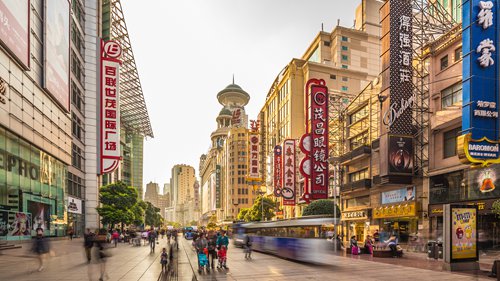
A view of Nanjing Road Pedestrian Street in Shanghai Photo: VCG
Walking along Nanjing Road in central Shanghai, clustered with colorful billboards, fancy boutiques and historic buildings, Li Zhenhai, 60, feels familiar and foreign at the same time.
Li, from East China's Shandong Province, first visited the metropolis 30 years ago. "I was awestruck back then," Li said. "You could find so many quality things you couldn't find elsewhere in China, so buying something in the city was a must-do." He bought himself a black woolen coat that kept him warm for the following 14 years.
This time around, the streets are still bustling and dazzling, but Li said he doesn't recognize many of the newly arrived foreign brands. In the past decade or so, multinationals such as Armani, Leica, Louis Vuitton and Starbucks have set up flagship stores in Shanghai to feed the growing demands of Chinese consumers.
That trend got a boost at the first China International Import Expo (CIIE) held between November 5 and 10 in the city. About 25 kilometers west of Nanjing Road, over 400,000 buyers from China and abroad packed into the National Exhibition and Convention Center (Shanghai) looking to buy imported goods and services being showcased by 3,600 companies from some 170 countries and regions.
China has pledged to welcome more foreign imports of services and products as well as greater opening-up. Shanghai, where the country set up its first pilot free trade zone (FTZ), will expand the FTZ and relax restrictions on foreign investment.
Exoticism and excitement
Located on China's central coastline, Shanghai was once called "the Paradise of Adventurers" by Mexican honorary consul Mauricio Fresco (using the pseudonym G.E. Miller) in 1937, the year when he saw the city go from its booming commercial culture heyday to its decline following Japanese aggression.
Miller's description, along with Shanghai's many other nicknames back then, such as "Paris of the Orient" and "Hollywood in China," underlined the persistent Western imagination of Shanghai as the essence of exoticism, excitement, color and vitality. But the city's modern-day development still echoes the romance of its past. After Shanghai's opening as a treaty port in the 1840s, it became China's earliest hub of East-West interaction, assimilation and competition.
At the Bund, one of the most famous Shanghai landmarks, located at the eastern end of Nanjing Road, two dozen colossal Western structures, ranging in style from art deco to Roman classical, stand side by side, forming an expansive marble curtain. Among these buildings is HSBC's former inland headquarters, set up in 1865. Between 1874 and 1890, the bank acted as the leading underwriter for about 70 percent of the foreign debt borrowed by the Qing regime.
It also led the way for the establishment of the Imperial Bank of China, the first Chinese commercial bank, in 1897, and a series of other financial institutions. The relationship between HSBC and Chinese banks were made apparent by two lion sculptures - Stephen and Stitt - placed outside HSBC headquarters and named after the bank's Shanghai manager and chief manager.
The lion pair are still present today in front of the headquarters of the Shanghai Pudong Development Bank, which uses the former HSBC building, as well as outside a branch of China Merchants Bank, which occupies another building just meters away. Early interaction with foreign businesses like HSBC helped Shanghai gain a step ahead of other Chinese cities in the financial sector, industry, pop culture and consumerism.
A return to paradise
Across the Huangpu River that runs along the Bund, glass-curtained modern skyscrapers dotting Lujiazui in Pudong New Area create an iconic city skyline. While the west bank of the river boasts historic remnants of former foreign concessions, the east bank is completely modern and futuristic.
None of these buildings existed 30 years ago, yet Lujiazui is now one of the most vibrant parts of Shanghai and even China, teeming with luxurious hotels, fine dining, bars and a colorful nightlife, all things that could only be found a century ago.
China's reform and opening-up policy has transformed the once-mostly marshland to a central business district with global influence. More than 200 of the world's Fortune 500 companies have invested in the area, according to municipal data, and financial heavyweights such as the Shanghai Stock Exchange have settled there.
Between 1990 and 2017, Pudong saw a total contracted foreign direct investment of $196.2 billion. These policies have turned Shanghai into an economic miracle. Along with CIIE and China's renewed promise of opening-up, the bewilderment felt by foreign settlers a century ago and common visitors to the city today will only continue to lure more free-spirit adventurers from around the world.
A survey on some 1,000 US companies doing business in China, released in July by the American Chamber of Commerce in Shanghai, shows 77 percent of US companies in China gained profits in 2017, with the same percentage seeing sales growth.
US carmaker Tesla Inc announced in July that it will set up its first overseas plant in Shanghai, and global robotics giant ABB released plans in October to build a "factory of the future" where "robots make robots" in the city.
In this new era of opening-up, Shanghai serves as a "boot camp" for companies aiming to get in touch with a more lucrative and promising market of 1.3 billion people.
"The consumption market underwent a major change in recent years," said Pan Zhiluan, deputy supervisor of a mega-shopping mall project in Shanghai. "We are focusing more on providing a good experience and convenience for consumers," Pan added, explaining that they want the newest, the fastest and the coolest.
And to adapt to the nightlife in the city, his mall will extend more working hours. Just as American writer Patricia Marx once put it, "New York may be the city that never sleeps, but Shanghai doesn't even sit down."




